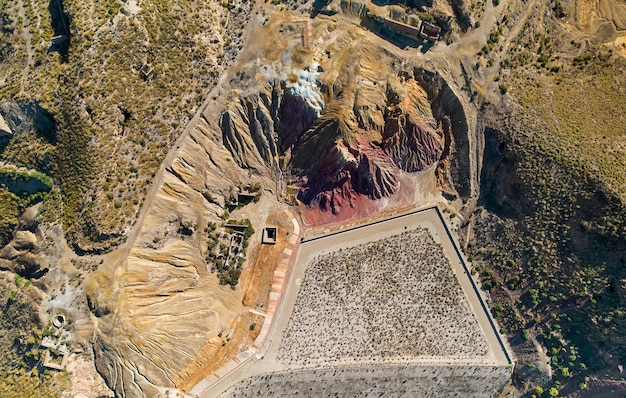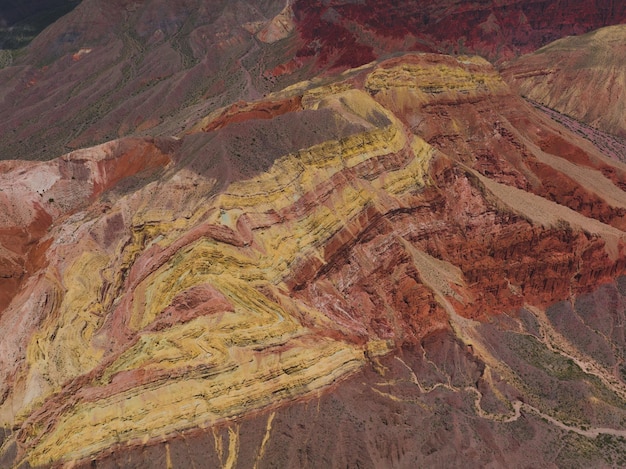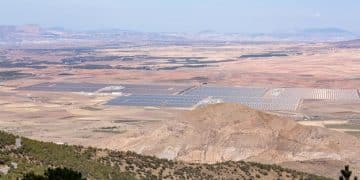Mexico’s mining industry: A guide for US investors

Mexico’s mining industry offers attractive high-return opportunities for US investors interested in strategic minerals and established operational frameworks, supported by a rich geological endowment and proximity to the United States.
For US investors eyeing global opportunities, Mexico’s Mining Industry: A Comprehensive Guide for US Investors Seeking High Returns provides a compelling narrative. This sector, characterized by its historical significance and vast mineral wealth, presents a unique blend of established operations, proximity to the United States, and the potential for substantial returns. Understanding the nuances of this industry is key to unlocking its full potential.
Understanding Mexico’s Mining Landscape
Mexico’s mineral wealth is not a recent discovery; it has been a cornerstone of its economy for centuries, shaping its development and geopolitical standing. This rich history provides a robust foundation for modern mining operations, distinguishing it from many other emerging markets. The country’s geological formations are renowned for their diversity and abundance, hosting significant deposits of precious metals like gold and silver, as well as crucial industrial minerals.
Historical Significance and Mineral Endowment
The legacy of mining in Mexico dates back to pre-Hispanic times, with the Spanish colonial era solidifying its role as a global silver powerhouse. This deep-rooted history means that infrastructure, though varying in modernity, exists around many established mining regions. Today, Mexico consistently ranks among the world’s top producers of silver, bismuth, fluorite, and zinc, and is a significant global player in gold, copper, and lead. This formidable mineral endowment is a primary draw for international investors.
Regulatory Framework and Investment Climate
Mexico’s mining sector operates under a legal and regulatory framework designed to govern exploration, exploitation, and beneficiation activities. The primary legislation is the Mining Law, which outlines concessions, environmental regulations, and social responsibilities. Changes to this framework, particularly those introduced in recent years, aim to enhance social equity and environmental protection, which can impact operational costs and project timelines. While these changes introduce new considerations, they also foster a more sustainable and predictable environment for long-term investments. The current administration has emphasized national control over strategic minerals, leading to some adjustments in concession policies, but the general investment climate remains open, albeit with increased scrutiny.
Key Minerals and Their Market Dynamics
The diversity of minerals extracted in Mexico is a significant advantage. Silver continues to be a flagship commodity, driven by both industrial demand and its role as a store of value. Gold production has also seen a resurgence, benefiting from global price trends and new discoveries. Copper, vital for the energy transition and infrastructure development, is another critical mineral, with significant deposits in states like Sonora. Industrial minerals such as fluorspar and baryte, though less glamorous, are essential inputs for various manufacturing processes, providing stable demand. The market dynamics for each of these minerals are influenced by global supply and demand, geopolitical factors, and technological advancements, all of which US investors must consider.
The ongoing global push towards renewable energy and electric vehicles is creating unprecedented demand for certain “energy transition minerals.” Mexico, with its known reserves of copper, lithium (though nascent), and other critical elements, is well-positioned to capitalize on this trend. Investors looking for long-term growth will find these specific mineral markets particularly attractive, as they are less susceptible to short-term economic fluctuations and more tied to structural shifts in the global economy. This makes the Mexican mining sector not just about traditional metals, but also about future-proof resources.
The government’s role in the mining industry is complex, balancing economic development with social considerations and environmental stewardship. Recent legislative changes have aimed to ensure that local communities benefit more directly from mining activities and that environmental standards are rigorously applied. While this might add layers of complexity to project development, responsible mining practices are increasingly valued by international investors and global markets. Dialogue and collaboration between mining companies, local communities, and governmental bodies are crucial for successful and sustainable operations.
Strategic Advantages for US Investors
US investors looking towards Mexico’s mining sector are presented with a unique confluence of geographical, economic, and logistical advantages that significantly de-risk and enhance potential returns. These advantages collectively forge a compelling case for cross-border investment.
Geographical Proximity and Supply Chain Efficiency
The shared border between the United States and Mexico is arguably the most significant logistical advantage. This close proximity facilitates shorter supply chains, reducing transportation costs and transit times for raw materials and finished products. For US-based processing facilities, Mexican mines offer a convenient and reliable source of minerals, minimizing dependence on more distant and potentially volatile regions. This leads to greater predictability in logistics and inventory management, crucial for industries reliant on a steady flow of materials. The established infrastructure, particularly along the border, further streamlines cross-border trade and movement of goods and personnel.
Trade Agreements and Economic Integration
The United States-Mexico-Canada Agreement (USMCA), which succeeded NAFTA, provides a stable and predictable trade environment for commodities and services between the three nations. For the mining industry, USMCA ensures streamlined customs procedures, protections for intellectual property, and a framework for dispute resolution. This legal certainty minimizes trade barriers and fosters an environment where US companies can invest with confidence, knowing their investments are protected by international agreement. The economic integration fostered by USMCA also promotes cross-border collaboration in technology transfer and best practices, enhancing operational efficiencies.
Skilled Labor and Operational Expertise
Mexico possesses a significant pool of skilled labor experienced in mining operations. Generations of mining activity have cultivated expertise in various aspects of the industry, from geological exploration and drilling to processing and metallurgy. This ready availability of experienced personnel can reduce training costs and accelerate project timelines. Many Mexican mining professionals are also familiar with international operational standards, making integration with US-managed projects smoother. Furthermore, the cost of labor in Mexico, while competitive, offers a cost-effective operational base compared to highly developed mining regions, contributing to healthier profit margins.
Access to Financing and Capital Markets
US investors benefit from well-developed financial markets that can facilitate capital raising for Mexican mining projects. Access to US exchanges, private equity firms, and commercial banks provides diverse financing options, from project finance to equity investments. This robust financial infrastructure means that promising projects can secure the necessary capital to move from exploration to production, unlike in some regions where capital might be scarcer or more expensive. The familiarity of US financial institutions with Mexican assets, particularly within the mining sector, also simplifies due diligence and transaction processes.
The ongoing efforts to modernize and formalize the Mexican mining sector also contribute to investor confidence. Initiatives aimed at improving transparency, combating illegal mining, and promoting corporate social responsibility align with the expectations of sophisticated US investors. While challenges exist, the overall trajectory points towards a more predictable and ethically sound investment environment, making the Mexican mining industry a more attractive proposition for long-term strategic capital.
Navigating Regulatory and Environmental Considerations
Investing in Mexico’s mining industry, while promising, necessitates a deep understanding of its evolving regulatory landscape and stringent environmental demands. Diligence in these areas is not merely a compliance issue but a fundamental component of sustainable and profitable operations.
Understanding Mining Concessions and Tenures
Mining concessions in Mexico grant the right to explore and exploit mineral resources within defined areas for a specified period, typically 50 years, renewable upon meeting certain criteria. The process involves application, technical and economic viability studies, and adherence to various legal requirements. Recent amendments to the Mining Law, however, have introduced more stringent conditions for obtaining and retaining concessions, emphasizing social responsibility and environmental impact assessments. Investors must diligently research the terms of existing concessions or the viability of new applications, understanding that the criteria for granting and renewal are now more complex and subject to greater governmental discretion. Transparency and clear communication with authorities are essential.
Environmental Impact Assessments and Permitting
Environmental compliance is paramount. All mining projects, irrespective of scale, require rigorous Environmental Impact Assessments (EIAs) approved by Mexico’s Ministry of Environment and Natural Resources (SEMARNAT). These assessments evaluate potential impacts on air, water, soil, biodiversity, and local communities, prescribing mitigation measures. The permitting process can be lengthy and complex, requiring detailed scientific studies and public consultations. Companies must demonstrate a clear commitment to environmental protection, often beyond the minimum legal requirements, to gain social license to operate. Failed environmental compliance can lead to significant fines, operational suspensions, and severe reputational damage, making it a critical area for upfront investment and ongoing vigilance.
Social Licensing and Community Relations
The concept of a “social license to operate” has gained significant traction in Mexico, meaning that even with legal permits, projects cannot proceed effectively without the acceptance and support of local communities. This involves ongoing dialogue, fair negotiation, and tangible benefits for affected populations, such as job creation, infrastructure development, and local procurement. Conflicts over land rights, water usage, and environmental concerns can lead to protests, blockades, and operational disruptions. Investors must prioritize robust community engagement strategies, foster transparent relationships, and implement corporate social responsibility (CSR) initiatives that address local needs and concerns. Ignoring community relations is a significant risk factor.
Water Usage Regulations and Management
Water scarcity is a growing concern in many regions of Mexico, particularly those where mining activities are concentrated. The National Water Commission (CONAGUA) regulates water usage, and mining operations require specific concessions for abstraction and discharge. Regulations impose strict limits on water consumption and mandate treatment before discharge to prevent contamination. Companies must invest in advanced water management technologies, such as recycling systems and efficient processing techniques, to minimize their water footprint. Proactive water stewardship is not only a regulatory requirement but also a strategic imperative for long-term operational viability and community acceptance, especially in arid regions.
The regulatory environment is dynamic, requiring continuous monitoring and adaptation. Legislative changes can occur, reflecting shifting governmental priorities or responses to social pressures. Engaging with legal experts specializing in Mexican mining law and environmental regulations is indispensable for any US investor. This proactive approach ensures that investments remain compliant, mitigate potential liabilities, and operate within the accepted legal and social frameworks, ultimately safeguarding the investment and fostering sustainable development.
Key Players and Investment Opportunities
The Mexican mining landscape is a vibrant ecosystem comprising major international and domestic players, alongside a plethora of junior explorers. For US investors, identifying the right entry points and understanding the capabilities of existing companies is crucial for successful investment strategies.
Major Mining Companies and Their Presence
Several global and national mining giants have a significant footprint in Mexico, leveraging the country’s rich mineral endowment and established infrastructure. Companies such as Industrias Peñoles, Fresnillo plc, Grupo México, Southern Copper Corporation, and Newmont operate large-scale mines across various commodities. These established players often offer stability and demonstrate proven operational expertise in the Mexican context. Investing in their shares or collaborating on projects can provide a more secure avenue for US investors seeking exposure to the sector. Their presence also indicates a degree of governmental and community acceptance for large-scale operations.
Junior Explorers and Development Projects
Beyond the majors, Mexico has a dynamic segment of junior exploration and development companies. These smaller entities are typically focused on identifying new deposits or advancing early-stage projects. While they carry higher inherent risks due to exploration uncertainty and capital requirements, they also offer the potential for substantial returns if successful. US investors with a higher risk appetite might find opportunities in funding these juniors through equity investments, joint ventures, or direct project financing. Due diligence on the geology, management team, and permitting status of such projects is paramount. Many juniors are publicly traded on stock exchanges in Canada or the US, providing an accessible investment vehicle.
Opportunities in Gold and Silver Mining
Mexico remains a premier destination for gold and silver mining. Its position as the world’s largest silver producer, combined with significant gold output, presents continuous opportunities. Investment can range from mature, producing mines that offer steady cash flows to advanced exploration projects with the potential for new discoveries. The global demand for these precious metals, driven by economic uncertainty and industrial applications, ensures a resilient market. Investing in companies with diversified portfolios across both gold and silver can further mitigate commodity-specific risks, providing a balanced exposure to the precious metals market.
Industrial Minerals and Base Metals Ventures
While precious metals often dominate headlines, Mexico’s industrial minerals and base metals sectors offer stable and often less volatile investment avenues. Copper, zinc, lead, and iron ore production are crucial for global industrial activity and infrastructure development. Mexico’s significant reserves and historical production in these areas make it an attractive supply source. Furthermore, specific industrial minerals like fluorite and baryte, which are vital for chemical, automotive, and energy industries, present niche but stable investment opportunities. These markets are less susceptible to speculative trading and are driven more by fundamental industrial demand, appealing to investors seeking steady, long-term returns. Investors should also consider the potential for “white metals” like lithium, though this sector is still in very early stages in Mexico.
For US investors, partnering with experienced local entities or engaging consultants with deep knowledge of the Mexican mining industry can be invaluable. This approach helps navigate the complexities of local regulations, cultural nuances, and market dynamics, maximizing the chances of successful and profitable investments. The opportunities are diverse, catering to various risk profiles and investment horizons, from established giants to promising new ventures.
Case Studies: Success Stories for US Investors
Examining successful ventures by US investors in Mexico’s mining sector offers tangible insights into effective strategies, demonstrating the real-world application of the advantages discussed. These examples highlight the potential for high returns and sustainable operations when executed with due diligence and strategic foresight.
A Flourishing Gold Operation in Sonora
One prominent example involves a US-based mid-tier gold producer that acquired a series of exploration properties in Sonora. Through systematic geological work and a phased investment approach, they transformed a promising prospect into a fully operational, high-grade gold mine. Their success stemmed from several key factors: leveraging advanced exploration technologies, securing long-term financing from US capital markets, and crucially, building strong relationships with local indigenous communities. The company invested significantly in local infrastructure, job creation, and environmental stewardship, earning a robust social license to operate. This deep community engagement mitigated potential conflicts and ensured smooth operations, leading to consistent production and impressive profitability, exceeding initial investor expectations.
Silver Production Expansion in Zacatecas
Another notable success is a US private equity firm’s investment in an established silver mine in Zacatecas that was facing operational challenges. Recognizing the underlying asset value and the potential for optimization, the firm brought in seasoned operational experts and invested in modernizing processing facilities. Their strategy included implementing strict cost controls, improving metallurgical recoveries, and expanding exploration efforts within the existing concession. This injection of capital and expertise revitalized the mine, significantly increasing silver output and reducing per-ounce production costs. The strategic decision to focus on efficiency gains and incremental expansion within a known resource base proved highly effective, yielding substantial returns for the investors when the asset was later divested to a larger mining company.
Strategic Copper Development in Baja California
A lesser-known but equally insightful case involves a US-based venture capital fund that identified and invested in an early-stage copper project in Baja California. The project held a significant, yet undeveloped, copper resource. The fund’s success was rooted in its ability to navigate the complex permitting process efficiently, utilizing local Mexican legal and environmental consultants. They meticulously completed the environmental impact assessments and secured all necessary federal and state permits. Furthermore, they brought in a Mexican partner with deep understanding of local logistics and community nuances, streamlining project development. The project, now transitioning into full-scale production, demonstrates how strategic partnerships and expert navigation of regulatory hurdles can unlock significant value, particularly in base metals crucial for the global energy transition.
Each of these case studies underscores common threads crucial for success: thorough due diligence, effective capital deployment, strong community engagement, and expert navigation of Mexico’s regulatory and environmental frameworks. They illustrate that while challenges exist, the rewards for well-planned and responsibly executed investments in Mexico’s mining sector can be substantial, making it a compelling destination for US investors seeking high returns. These real-world examples serve as powerful testimonials to the untapped potential that remains within the country’s diverse mineral wealth. Investors should look for opportunities that align with these successful blueprints.
Future Outlook and Emerging Trends
The Mexican mining industry, while steeped in tradition, is not static; it is continually evolving, influenced by global dynamics, technological advancements, and shifting internal policies. Understanding these future trends is crucial for US investors seeking to position themselves strategically for long-term growth and sustained returns.
Technological Advancements and Efficiency Gains
The future of mining in Mexico will increasingly hinge on the adoption of cutting-edge technologies. Automation, artificial intelligence (AI), and data analytics are already being integrated into larger operations to optimize processes, improve safety, and enhance resource recovery. Predictive maintenance fueled by IoT sensors can minimize downtime, while advanced geological modeling improves exploration success rates. For US investors, identifying Mexican mining companies that are actively embracing these technological shifts may indicate a stronger competitive advantage and higher operational efficiencies. Investment in technology-driven startups within the mining ecosystem could also present attractive opportunities, particularly those focused on sustainable practices and reduced environmental footprints.
Sustainability and ESG (Environmental, Social, Governance) Focus
Environmental, Social, and Governance (ESG) factors are no longerperipheral considerations but central tenets of responsible mining, increasingly influencing investment decisions globally. In Mexico, this translates to greater emphasis on reducing carbon emissions, conserving water, minimizing waste, and ensuring benefits for local communities. Companies demonstrating strong ESG performance are likely to attract more capital, face fewer regulatory hurdles, and command better social license. US investors, particularly those with mandates for responsible investing, will find the Mexican sector’s growing commitment to ESG principles attractive. This shift also creates opportunities for service providers specializing in sustainable mining solutions.
Shifting Global Commodity Demands
The global push towards decarbonization and green technologies is reshaping commodity demands. While precious metals like gold and silver will retain their value, the demand for “transition minerals” such as copper, lithium, and rare earth elements is set to surge. Mexico’s abundant copper reserves position it favorably, and ongoing exploration for lithium, though nascent, could unlock significant potential. US investors should monitor these evolving commodity supercycles, considering investments in Mexican projects that align with these long-term demand trends. Diversifying portfolios to include exposure to these critical minerals can provide resilience against traditional commodity market fluctuations.
Regulatory Evolution and Government Stance
The Mexican government’s stance on mining continues to evolve. While there’s a strong desire to maximize national benefits from mineral wealth, there’s also an understanding of the need to attract and retain foreign investment. Future regulatory changes are likely to focus on strengthening domestic supply chains for critical minerals, enhancing environmental protections, and ensuring equitable distribution of mining benefits. While some legislative adjustments may introduce initial uncertainties, they often aim to create a more stable and predictable environment in the long run. US investors will need to stay abreast of legislative developments and engage proactively with stakeholders to understand the implications for their investments. The emphasis on strengthening national mining companies might also open doors for partnerships or joint ventures.
Overall, the future of Mexico’s mining industry appears to be one of cautious but significant growth, driven by technological integration, a heightened focus on sustainability, and evolving global commodity trends. For discerning US investors, the sector presents a mosaic of opportunities, provided they align their strategies with these emerging dynamics and embrace responsible investment practices. Proactive engagement and adaptability will be key to unlocking continued high returns.
| Key Aspect | Brief Description |
|---|---|
| 🗺️ Geographical Proximity | Close to US reduces logistics costs and transit times for efficient supply chains. |
| 💰 High Return Potential | Rich mineral endowment in gold, silver, copper, and industrial minerals offers significant profitability. |
| ⚖️ Regulatory Evolution | Evolving laws emphasize sustainability & community benefits, ensuring more responsible investments. |
| 📈 Economic Integration | USMCA facilitates stable trade and investment frameworks, reducing barriers for US capital. |
Frequently Asked Questions
▼
Mexico is a leading global producer of several key minerals. Notably, it is the world’s largest producer of silver and a top producer of bismuth, fluorite, and zinc. The country also boasts significant production of gold, copper, lead, and iron ore, making its mining sector diverse and resilient to fluctuations in demand for any single commodity.
▼
The USMCA (United States-Mexico-Canada Agreement) provides a stable and predictable framework for trade and investment. For US investors in Mexican mining, it ensures legal certainty, reduces trade barriers through harmonized customs procedures, and offers mechanisms for dispute resolution. This stability fosters confidence, making it easier for US firms to plan and execute long-term investments in the Mexican mining sector.
▼
Mexican mining operations are subject to strict environmental regulations, primarily enforced by SEMARNAT. Key requirements include conducting comprehensive Environmental Impact Assessments (EIAs), obtaining specific permits for water usage, managing solid waste, and treating wastewater. Companies are expected to implement mitigation measures to minimize environmental impact and demonstrate a strong commitment to responsible environmental stewardship throughout their operations.
▼
While Mexico is still in the early stages of developing its lithium resources, significant potential exists, especially given the global demand for electric vehicle batteries. The government has recently nationalized lithium, indicating a new phase of development likely involving state-owned enterprises or specific partnerships. Opportunities for US investors may arise through ancillary services, technology transfer, or, in the future, through carefully structured joint ventures in the broader energy transition minerals sector.
▼
Social license to operate (SLO) refers to the ongoing approval and acceptance of local communities and stakeholders for a mining project. In Mexico, it’s crucial because community opposition can lead to operational disruptions, legal challenges, and reputational damage. Achieving SLO requires transparent communication, equitable distribution of benefits (jobs, infrastructure), addressing community concerns (water usage, land rights), and respecting local cultures and traditions. It’s as important as legal permits for long-term project viability.

Conclusion
Mexico’s mining industry presents a multifaceted and compelling case for US investors seeking high returns. Despite evolving regulatory landscapes and the imperative for robust social and environmental practices, the sector’s inherent strengths—rooted in its vast mineral endowment, geographical advantages, and established trade frameworks—offer significant growth potential. Success stories underscore that strategic investments, coupled with diligent navigation of local nuances and a commitment to sustainable operations, can yield substantial and lasting profitability. As global demand shifts towards new energy minerals and technological integration becomes paramount, Mexico’s mining sector remains poised for continued expansion, inviting informed and responsible US capital to partake in its future prosperity.






